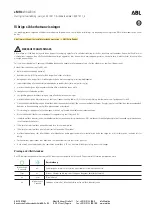
Starting and driving
4-55
4
Inspection and maintenance following
rough road operation
E00606700338
After operating the vehicle in rough road conditions, be sure to
perform the following inspection and maintenance procedures:
●
Check that the vehicle has not been damaged by rocks,
gravel, etc.
●
Carefully wash the vehicle with water.
Drive the vehicle slowly while lightly depressing the
brake pedal in order to dry out the brakes. If the brakes
still do not function properly, we recommend you to have
the brakes checked as soon as possible.
●
Remove the insects, dried grass, etc. clogging the radiator
core.
●
After driving through water, check the engine, transmis-
sion and differential oil. If the oil or grease is milky or
cloudy because of water contamination, it must be
replaced with new oil or grease.
●
Check the inside of the vehicle. If water entry is found,
dry the carpet etc.
●
Inspect the headlamps, If the headlamp bulb is flooded
with water, we recommend you to have it drained.
Cautions on the handling of 4-wheel drive
vehicles
E00606800397
Tyres and wheels
Since the driving torque can be applied to the 4 wheels, the
driving performance of the vehicle when operating in 4-wheel
drive is greatly affected by the condition of the tyres.
Pay close attention to the tyres.
●
Install only the specified tyres on all wheels. Refer to
“Tyres and wheels” on page 9-12.
●
Be sure all 4 tyres and wheels are the same size and type.
When it is necessary to replace any of the tyres or wheels,
replace all four.
●
All tyres should be rotated before the wear difference
between the front and rear tyres is recognisable.
Good vehicle performance cannot be expected if there is a dif-
ference in wear between tyres. Refer to “Tyre rotation” on page
8-20.
●
Check the tyre inflation pressure regularly.
CAUTION
!
●
Always use tyres of the same size, type, and same
brand that have no wear differences. Using tyres of
different size, type, brands or degree of wear, will
increase the differential oil temperature and result
in possible damage to the driving system. Further,
the drive train will be subject to excessive loading,
possibly leading to oil leakage, component seizure,
or other serious failures.
Summary of Contents for Outlander 2007
Page 1: ...English OWNER S MANUAL OUTLANDER ...
Page 86: ......
Page 90: ...2 4 Seat and seat belts 2 To collapse the second seat P 2 25 5 persons 7 persons ...
Page 160: ......
Page 242: ......
Page 334: ......
Page 434: ...5 100 For pleasant driving 5 Voice Command Tree E00730400027 ...
Page 435: ...For pleasant driving 5 101 5 Voice Command Tree Phonebook E00730500028 ...
Page 436: ...5 102 For pleasant driving 5 Voice Command Tree Setup E00730600029 ...
Page 518: ......
Page 594: ...9 4 Specifications 9 Front of the vehicle 2400 models 3000 models ...
Page 615: ......
Page 616: ......
Page 617: ......
Page 618: ......
















































